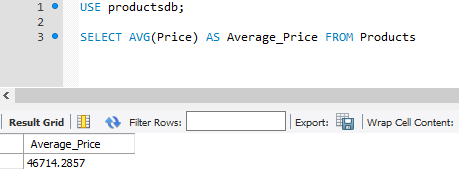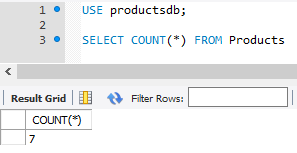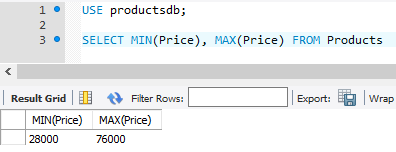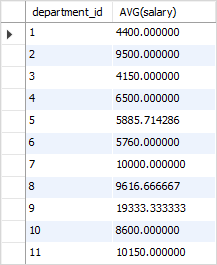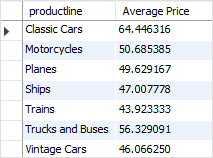In this article, we are going to see how to find the average value in a column in SQL. A column in the SQL table is the vertical catalog structure. In this article, we will be using the Microsoft SQL Server as our database.
For the purpose of example, we will be creating a sample table and performing the same operations on it.
Table Definition:
We have the following car table in our database :
CREATE TABLE car ( companyid integer , companyname varchar(20) , totalmodels integer )
The above query creates a car table for us.
Adding Data to Table:
To insert values into the table we need to use the insert statement. Use the below statement to add data to the car table:
INSERT INTO car values(1,'maruti suzuki',10); INSERT INTO car values(2,'tata',12); INSERT INTO car values(3,'volkswagen',8);
The above query will add the data to the car table.
Note: We have to insert values according to the table created. For example, we created a car table with companyid as integer, companyname as varchar, and totalmodels as an integer. So, we need to insert an integer, a character, and an integer else we may get an error.
To verify the contents of the table use the below statement:
SELECT * FROM car;
This will show us our created table as shown below:
Average of all values in a column
For this, we need to use avg() function. We have to pass the column name as a parameter. The avg() function has the following syntax:
SELECT AVG( column_name ) FROM table_name;
- The avg() function can be used with the SELECT query for retrieving data from a table.
The below query can be used to find the average of the totalmodels column of our cars table:
SELECT AVG(totalmodels) FROM car;
Output :
Let’s verify the output. The average of 10, 12, and 18 is 10. Hence, we have successfully found out the average of all values n a column of a table.
Finding out the Average without using the AVG() function –
In this approach we will see how we can find out the average value of a column without using the AVG() function. For this purpose we will use two function SUM() and COUNT(). Firstly we will sum all of the values of a certain column and then divide it with the number of elements of that column.
Considering the table is already created and the values are being inserted.
Syntax of SUM()
SELECT SUM(Col_name) FROM Table_Name;
Syntax of COUNT()
SELECT COUNT(Col_Name) FROM Table_Name;
SQL Code –
SELECT SUM(totalmodels) / COUNT (totalmodels) AS Average FROM car;
Output –
Here in this code an alias “Average” has been used to make the output column name “Average”, if the user doesn’t want to use that then they might skip this.
Last Updated :
25 Mar, 2023
Like Article
Save Article
Функция SQL AVG
Функция SQL AVG необходимо в случае, если требуется вычислить среднее значение числового столбца в таблице. Среднее значение функция AVG() в SQL вычисляет среднее значение столбца путем суммирования всех значений записей столбца и деления на количество записей.
AVG SQL Примеры
Рассмотрим пример. Допустим в таблице Price есть столбец Price_unit. В этой таблице содержатся 5 записей. Значения полей столбца Price_unit 3, 5, 14, 38 и 83.
Выполним запрос, возвращающий среднее значение столбца Price_unit
SELECT AVG(Price_unit) AS PriceAvg FROM Price;
Результатом выполнения данного запроса будет
PriceAvg = 28,6
Агрегатные функции
Последнее обновление: 21.05.2018
Агрегатные функции вычисляют некоторые скалярные значения в наборе строк. В MySQL есть следующие агрегатные функции:
-
AVG: вычисляет среднее значение
-
SUM: вычисляет сумму значений
-
MIN: вычисляет наименьшее значение
-
MAX: вычисляет наибольшее значение
-
COUNT: вычисляет количество строк в запросе
Все агрегатные функции принимают в качестве параметра выражение, которое представляет критерий для определения значений. Зачастую, в качестве
выражения выступает название столбца, над значениями которого надо проводить вычисления.
Выражения в функциях AVG и SUM должно представлять числовое значение (например, столбец, который хранит числовые значения).
Выражение в функциях MIN, MAX и COUNT может представлять числовое или строковое значение или дату.
Все агрегатные функции за исключением COUNT(*) игнорируют значения NULL.
Avg
Функция Avg возвращает среднее значение на диапазоне значений столбца таблицы.
Например, пусть есть следующая таблица товаров Products:
CREATE TABLE Products
(
Id INT AUTO_INCREMENT PRIMARY KEY,
ProductName VARCHAR(30) NOT NULL,
Manufacturer VARCHAR(20) NOT NULL,
ProductCount INT DEFAULT 0,
Price DECIMAL NOT NULL
);
INSERT INTO Products(ProductName, Manufacturer, ProductCount, Price)
VALUES
('iPhone X', 'Apple', 3, 76000),
('iPhone 8', 'Apple', 2, 51000),
('iPhone 7', 'Apple', 5, 32000),
('Galaxy S9', 'Samsung', 2, 56000),
('Galaxy S8', 'Samsung', 1, 46000),
('Honor 10', 'Huawei', 5, 28000),
('Nokia 8', 'HMD Global', 6, 38000)
Найдем среднюю цену товаров из базы данных:
SELECT AVG(Price) AS Average_Price FROM Products
Для поиска среднего значения в качестве выражения в функцию передается столбец Price. Для получаемого значения устанавливается псевдоним Average_Price, хотя
в принципе устанавливать псевдоним необязательно.
На этапе выборки можно применять фильтрацию. Например, найдем среднюю цену для товаров определенного производителя:
SELECT AVG(Price) FROM Products WHERE Manufacturer='Apple'
Также можно находить среднее значение для более сложных выражений. Например, найдем среднюю сумму всех товаров, учитывая их количество:
SELECT AVG(Price * ProductCount) FROM Products
Count
Функция Count вычисляет количество строк в выборке. Есть две формы этой функции. Первая форма COUNT(*) подсчитывает число строк в выборке:
SELECT COUNT(*) FROM Products
Вторая форма функции вычисляет количество строк по определенному столбцу, при этом строки со значениями NULL игнорируются:
SELECT COUNT(Manufacturer) FROM Products
Min и Max
Функции Min и Max вычисляют минимальное и максимальное значение по столбцу соответственно.
Например, найдем минимальную цену среди товаров:
SELECT MIN(Price), MAX(Price) FROM Products
Данные функции также игнорируют значения NULL и не учитывают их при подсчете.
Sum
Функция Sum вычисляет сумму значений столбца. Например, подсчитаем общее количество товаров:
SELECT SUM(ProductCount) FROM Products
Также вместо имени столбца может передаваться вычисляемое выражение. Например, найдем общую стоимость всех имеющихся товаров:
SELECT SUM(ProductCount * Price) FROM Products
All и Distinct
По умолчанию все вышеперечисленных пять функций учитывают все строки выборки для вычисления результата. Но выборка может содержать повторяющие значения.
Если необходимо выполнить вычисления только над уникальными значениями, исключив из набора значений повторяющиеся данные, то для
этого применяется оператор DISTINCT.
SELECT COUNT(DISTINCT Manufacturer) FROM Products
По умолчанию вместо DISTINCT применяется оператор ALL, который выбирает все строки:
SELECT COUNT(ALL Manufacturer) FROM Products
В данном случае мы видим, что производители могут повторяться в таблице, так как некоторые товары могут иметь одних и тех же производителей. Поэтому
чтобы подсчитать количество уникальных производителей, необходимо использовать оператор DISTINCT.
Так как этот оператор неявно подразумевается при отсутствии DISTINCT, то его можно не указывать.
Комбинирование функций
Объединим применение нескольких функций:
SELECT COUNT(*) AS ProdCount, SUM(ProductCount) AS TotalCount, MIN(Price) AS MinPrice, MAX(Price) AS MaxPrice, AVG(Price) AS AvgPrice FROM Products
Summary: this tutorial, we will show you how to use SQL AVG function to get the average value of a set.
Introduction to SQL AVG function
The SQL AVG function is an aggregate function that calculates the average value of a set. The following illustrates the syntax of the SQL AVG function:
Code language: SQL (Structured Query Language) (sql)
AVG([ALL|DISTINCT] expression)
If we use the ALL keyword, the AVG function takes all values in the calculation. By default, the AVG function uses ALL whether we specify it or not.
If we specify the DISTINCT keyword explicitly, the AVG function will take the unique values only in the calculation.
For example, we have a set of (1,2,3,3,4) and apply the AVG(ALL) to this set, the AVG function will perform the following calculation:
Code language: SQL (Structured Query Language) (sql)
(1+2+3+3+4)/5 = 2.6
However, the AVG(DISTINCT) will process as follows:
Code language: SQL (Structured Query Language) (sql)
(1+2+3+4)/4 = 2.5
SQL AVG function examples
We will use the employees table in the sample database to demonstrate how the SQL AVG function works. The following picture illustrates the structure of the employees table:
To calculate the average salary of all employees, you apply the AVG function to the salary column as follows:
Code language: SQL (Structured Query Language) (sql)
SELECT AVG(salary) FROM employees;
Try It
Let’s apply the DISTINCT operator to see if the result changes:
Code language: SQL (Structured Query Language) (sql)
SELECT AVG(DISTINCT salary) FROM employees;
Try It
It changed because some employees have the same salary.
To round the result to 2 decimal places, you use the ROUND function as follows:
Code language: SQL (Structured Query Language) (sql)
SELECT ROUND(AVG(DISTINCT salary), 2) FROM employees;
Try It
To calculate the average value of a subset of values, we add a WHERE clause to the SELECT statement. For instance, to calculate the average salary of employees in the department id 5, we use the following query:
Code language: SQL (Structured Query Language) (sql)
SELECT AVG(DISTINCT salary) FROM employees WHERE department_id = 5;
Try It
The following statement returns the average salary of employees who hold the job id 6:
Code language: SQL (Structured Query Language) (sql)
SELECT AVG(salary) FROM employees WHERE job_id = 6;
Try It
SQL AVG with GROUP BY clause example
To calculate the average values of groups, we use the AVG function with the GROUP BY clause. For example, the following statement returns the departments and the average salary of employees of each department.
Code language: SQL (Structured Query Language) (sql)
SELECT department_id, AVG(salary) FROM employees GROUP BY department_id;
Try It
We can use the inner join clause to join the employees table with the departments table to get the department name data:
Code language: SQL (Structured Query Language) (sql)
SELECT e.department_id, department_name, AVG(salary) FROM employees e INNER JOIN departments d ON d.department_id = e.department_id GROUP BY e.department_id;
Try It
SQL AVG with ORDER BY clause example
To sort the result set that includes the AVG results, you use the AVG function in the ORDER BY clause as follows:
SELECT e.department_id, department_name, AVG(salary) FROM employees e INNER JOIN departments d ON d.department_id = e.department_id GROUP BY e.department_id ORDER BY AVG(salary) DESC;
Try It
SQL AVG with HAVING clause example
To filter group, you use the AVG function in the HAVING clause. For example, the following statement gets the department that has the average salary less than 5000:
SQL AVG with a subquery
We can apply AVG function multiple times in a single SQL statement to calculate the average value of a set of average values.
For example, we can use the AVG function to calculate the average salary of employees in each department, and apply the AVG function one more time to calculate the average salary of departments.
The following query illustrates the idea:
Code language: SQL (Structured Query Language) (sql)
SELECT AVG(employee_sal_avg) FROM ( SELECT AVG(salary) employee_sal_avg FROM employees GROUP BY department_id ) t;
Try It
How the query works.
- The subquery returns a set of the average salaries of employees for each department.
- The outer query returns the average salary of departments.
In this tutorial, you have learned how to use the SQL AVG function to calculate the average value of a set.
Was this tutorial helpful ?
Summary: in this tutorial, you will learn how to use MySQL AVG() function to calculate the average value of a set of values.
Introduction to MySQL AVG() function
The MySQL AVG() function is an aggregate function that allows you to calculate the average value of a set.
Here is the basic syntax of the AVG() function:
AVG(DISTINCT expression)Code language: SQL (Structured Query Language) (sql)You use the DISTINCT operator in the AVG function to calculate the average value of the distinct values.
For example, if you have a set of values 1,1,2,3, the AVG function with DISTINCT operator will return 2 i.e., (1 + 2 + 3) / 3.
We will use the products table in the sample database for the demonstration:
A) Using MySQL AVG() function to calculate an average of all values in a column example
This example uses the AVG() function to calculate the average buy price of all products from the products table:
SELECT
AVG(buyprice) 'Average Price'
FROM
products;Code language: SQL (Structured Query Language) (sql)Try It Out
B) Using MySQL AVG() function with a WHERE clause example
The following example uses the AVG() function to calculate the average buy price of products in the product line Classic Cars:
SELECT
AVG(buyprice) 'Average Classic Cars Price'
FROM
products
WHERE
productline = 'Classic Cars';Code language: SQL (Structured Query Language) (sql)Try It Out
In this example, the WHERE clause has a condition that includes only the Classic Cars product line. Therefore, the AVG() function calculates the average value for the buy prices of products in Classic Cars only.
C) Using MySQL AVG with DISTINCT option example
This query checks if there are any products which have the same prices:
SELECT
COUNT(buyprice) - COUNT(DISTINCT buyprice)
FROM
products;Code language: SQL (Structured Query Language) (sql)Try It Out
This query uses the AVG() function with the DISTINCT option to calculate the average of distinct buy prices:
SELECT
FORMAT(AVG(DISTINCT buyprice), 2)
FROM
products;Code language: SQL (Structured Query Language) (sql)Try It Out
Notice that the result is different from the average buy price without using the DISTINCT operator.
D) MySQL AVG with GROUP BY clause example
The AVG() function is often used in conjunction with the GROUP BY clause to calculate the average value for each group of rows in a table.
For example, to calculate the average buy price of products for each product line, you use the AVG() function with the GROUP BY clause as the following query:
SELECT
productline,
AVG(buyprice) 'Average Price'
FROM
products
GROUP BY productline;Code language: SQL (Structured Query Language) (sql)Try It Out
E) Using MySQL AVG() function with a HAVING clause example
You can use the AVG() function in the HAVING clause to set conditions for the average values of groups.
For example, if you want to select only product lines that have the product’s average buy prices greater than 50, you can use the following query:
SELECT
productline,
AVG(buyprice) 'Average Price'
FROM
products
GROUP BY productline
HAVING AVG(buyprice) > 50;Code language: SQL (Structured Query Language) (sql)Try It Out
F) Using MySQL AVG() function with a subquery example
You can use the AVG() function in an SQL statement multiple times to calculate the average value of a set of average values.
This query uses the AVG() function to calculate the average buy price of the average buy prices of product lines:
SELECT
AVG(pl_avg) 'Average Product'
FROM
(SELECT
AVG(buyprice) pl_avg
FROM
products
GROUP BY productline) avgs;Code language: SQL (Structured Query Language) (sql)Try It Out
How it works.
- The subquery calculates the average buy price by product lines.
- The outer query calculates the average buy price of the average buy prices of product lines returned from the subquery.
G) Using MySQL AVG() function with NULL example
The AVG() function ignores NULL values in the calculation. See the following example:
First, create a new table named t with two columns id and val. The val column can contain NULL values.
CREATE TABLE IF NOT EXISTS t (
id INT AUTO_INCREMENT PRIMARY KEY,
val INT
);Code language: SQL (Structured Query Language) (sql)Second, insert some rows into the t table, including NULL value.
INSERT INTO t(val)
VALUES(1),(2),(nulL),(3);Code language: SQL (Structured Query Language) (sql)Third, calculate the average value of the values in the val column by using the AVG function:
SELECT
AVG(val)
FROM
t;Code language: SQL (Structured Query Language) (sql)The statement returns 2 as expected because the NULL value is not included in the calculation of the AVG function.
H) Using MySQL AVG() function with control flow functions
To calculate the average value of a column and calculate the average value of the same column conditionally in a single statement, you use AVG() function with control flow functions e.g., IF, CASE, IFNULL, and NULLIF.
For example, to calculate the ratio of the average buy price of Classic Cars product line to average buy price of all products, you use the following statement:
SELECT
AVG(IF(productline = 'Classic Cars',
buyprice,
NULL)) / AVG(buyprice) 'Classic Cars/ Products'
FROM
products;Code language: SQL (Structured Query Language) (sql)Try It Out
The IF(productline='Classic Cars',buyprice,NULL) expression returns the buy price if the product line is Classic Cars, otherwise NULL.
Because the AVG() function ignores the NULL values in the calculation so the AVG(IF(productline='Classic Cars',buyprice,NULL)) expression returns the average buy price for only products whose product line is Classic Cars.
In this tutorial, you have learned some useful techniques to calculate the average value of a set of values by using theAVG() function.
Was this tutorial helpful?






